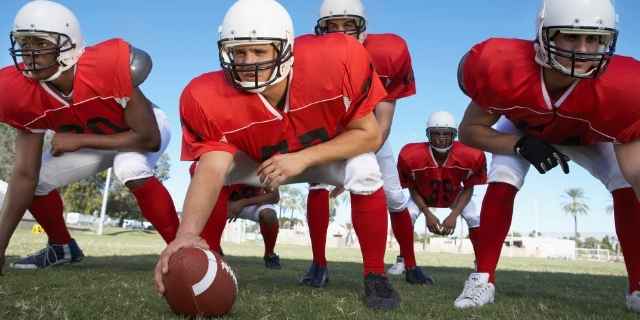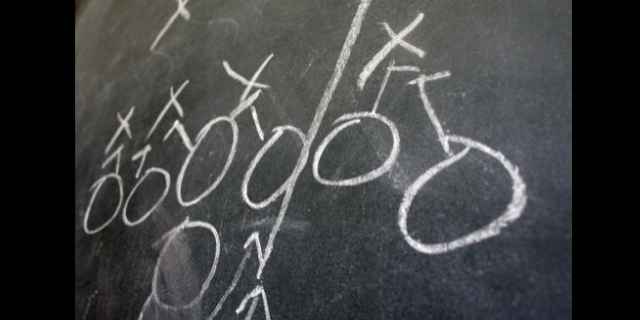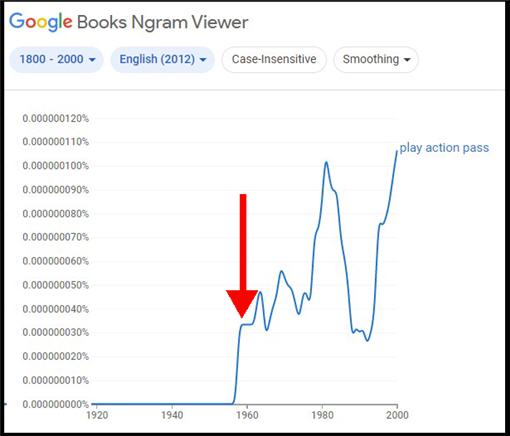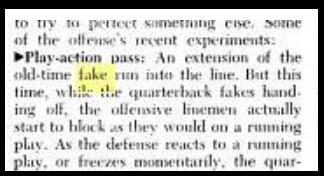It’s common to hear the term “play-action pass” or simply “play-action” used by commentators calling an NFL game.
To the casual observer, these play-action passes don’t look any different from other pass plays. So what makes a pass play a play-action?
What is A Play-Action Pass?
A play-action pass is a play that starts out looking like a run play with a fake handoff but turns into a pass play.
It’s the opposite of the draw play, which starts out looking like a pass but turns into a run.
The play-action can start either with the quarterback right behind the center or standing back in the shotgun formation.

Role of the linemen
When the ball is snapped, the linemen fire out into the defensive lineman like they would on a run play.
If the play works, the defensive lineman will cease their rush to look for the ball carrier.
Role of the running back
At the same time, the quarterback fakes a handoff to a running back and rolls out to one side.
The running back charges the line, pretending to be holding the ball.
Seeing this, the linebackers (and maybe even the defensive backs) will crash the line in an attempt to stop the run.
Role of the quarterback
This opens up space behind the line.
The quarterback will throw a quick pass to a receiver who has moved into the opening.
What Is The Play-Action Pass Good For?
The play-action is usually good for gains of five to ten yards.
But occasionally it results in breaks for long gains or even touchdowns.
For this to work, the defense has to actually fear the offense’s ability to run the ball.
If you aren’t a good running team, the play-action won’t be very effective.
Statistically, the more running plays a team has run in a given game, the more successful their play-action will be.
Linemen And The Play-Action Pass

The play-action takes a lot of work to perfect. Offensive linemen have the hardest job to make it effective.
For the play to succeed, the defense has to believe that a run is coming.
Offensive players study film of themselves on running plays just so that they can learn to mimic how they move on a run when it comes time to do a play action!
In a typical pass play, offensive linemen drop back on the snap and form a defensive pocket.
This is because an offensive lineman is prohibited from being more than a few yards past the line of scrimmage on a passing play.
On running plays, they fire out into the defensive lineman and try to drive them back.
So, the offensive lineman must convince the defense that they are trying to drive them back, without actually driving them too far!
Quarterback And The Play-Action Pass
The quarterback can start either under center or back in the shotgun.
Under center is generally considered more effective. This is because when he starts under center, he turns his back to make a handoff, further disguising what’s happening.
The quarterback rolls to the side, hopefully freezing any unblocked defenders, then quickly throws to a receiver.
Similar Plays
We mentioned in the introduction that the play-action pass can look quite similar to other moves.
Let’s take a run through them.
The Flea-Flicker
A flea-flicker is also a pass that looks like a run.
But instead of faking the handoff, the quarterback hands off to the running back.
The running back charges the line but turns and lobs the ball back to the quarterback at the last second.
The quarterback then throws the pass.
The Run-Pass Option
The Run-Pass Option is also known as the RPO.
This is more commonly a college play but is starting to come into use by some NFL teams.
In a run-pass option, the running back assumes he is getting the ball.
When the time for the handoff comes, the quarterback has a split second to decide whether to give the back the ball or to keep it himself and pass.
The halfback option is a variation of this.
How Did The Play-Action Pass Get Its Name?
We have a separate article that explores who invented the play-action pass.
Here, we’ll consider how the play got its name.
First appearance in print
When we searched through the Google Library, we found that the term “play-action pass” first appeared in books in 1960.
Prentice-Hall published a manual that year called “How To Train The Quarterback”. The book refers to “the play-action pass series”.
We also know that a 1961 edition of the Philadelphia Daily News used the term.
Here’s the graph for “play action pass” from the Google Books Ngram Viewer. This analyzes the vast library that Google has indexed. As you can see, the term appears in 1960 and ebbs and flows in popularity.

Newsweek had an article explaining the play-action pass in 1963.
Apologies for the quality of this image, but it’s a magnified excerpt of the page. There is a section that describes the “Play-action pass” – you can see the phrase in bold in the image.

The section defines it like this:
An extension of the old-time fake run into the line. But this time, while the quarterback fakes handing off, the offensive linemen actually start to block as they would on a running play.
The article goes on to describe how the quarterback throws the pass when the defense reacts to a running play or they freeze momentarily.